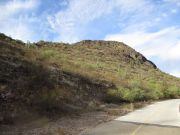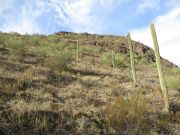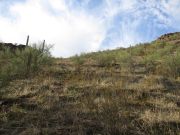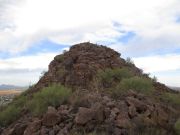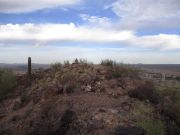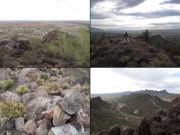Rillito Benchmark is a rocky hill at the very northern tip of the Tucson Mountains, in the town of Marana about 20 miles north of Tucson. It sits beside the freeway with easy access and can be hiked (and scrambled) in less than an hour, a good way to break up a drive.
The Santa Cruz River runs below the peak, running northwest to southeast. These days, the Santa Cruz is dammed and mostly dry, but historically it has been one of Arizona's major rivers, starting south in Mexico and eventually to the Gila River.
The word "Rillito" is a gringo-ization of the Spanish word for "river" (rio) in its diminutive form by adding the "ito" to it. It is pronounced "Re-eeto", but I'm sure plenty of people pronounce the l's. Apparently, in actual Spanish, they wouldn't do it this way.
This is a popular peak for Tucson hikers because it's easy to get to, but it's not a peak I would drive all this way for. It's a good add-on peak if climbing other peaks in the area (for example, Safford Peak is close by), or if passing through. But me, every time I'm in the area, I'm either too tired, too lazy or it's too hot.
However, today worked out well. I was driving from Bisbee to Tempe and wanted something very short to break up the drive. The weather was cool (in the high 50s) with heavy clouds. It seemed right that I wouldn't have blue skies for this hike. Had it been nicer, I probably would have tried to find something more photogenic to hike.
I exited the interstate at Avra Valley Road and went west about a mile until north of the peak, parking in a cleared area. A big cement plant rises to the south and there are a lot of trucks that rumble along this road. There is a paved bike and jogging path that runs through here, paralleling the Santa Cruz River and its thicket of trees. I was the third car in the lot. I went light: just my keys, wallet, phone, camera, a bottle of water and my poles. I didn't even carry a pack.
I walked the path about a quarter mile to place myself below a slope that lies between the two main rocky knobs of this short ridge. The slope here looked friendlier than if I tried busting directly up from the parking area. I found a messy way up the road-cuts, and yes, the slope was lovely, laying back well. I even found a path, but it wasn't necessary. The terrain was not too brushy everything held together well. It took less than ten minutes to get myself onto the ridge. I was southeast of the peak.
Looking up, there is a rocky "gendarme" in this saddle, then the main rocky mass of the summit behind it, the top less than an eighth of a mile away. I sidehilled right around the gendarme, then up to the base of the main summit mass. From afar, it looks like one big vertical heap of rocks, but once closer, all sorts of ledges, ramps, and chutes open up. There is no one official route. I saw no cairns nor paths. I'd be figuring this out rock by rock.
The rock hopping was easy, and when I was now in the ramps and chutes, I just went up whatever looked easiest. There was one small segment where I had to shimmy up one big rock step and then sidle by another rock with about eight feet of exposure below me. This may have been the one and only "low class 3" move of the day.
The rest of the climb was easy scrambling with hands used for balance, until I was on top. There are two cairns, one at the highpoint and one a few feet from it, not sure why. I did not see any registers. The benchmark itself has long been removed. I was able to find where it was mounted, its stem still present. I was unable to find any reference marks but I did not look that hard. The datasheet for the benchmark notes that as of a 1975 "recovery", the benchmark was already gone.
I did not stop to rest as I really hadn't broken much of a sweat, the climb taking about thirty minutes. I snapped a few lousy images then started back down. I was privy to a gentle breeze that made the cool temperatures feel chillier. I retraced my route down, with some variations. As usual, I'd see a way down that looked easy, something I wouldn't have noticed on the ascent.
I was back to my car quickly, the round trip taking less than an hour. I changed into driving clothes and started the second leg of the drive back to Tempe. This was a worthy little bump to climb. It went fast, but still required some hands and footwork to get up, so it wasn't exactly a trivial climb either. The scrambling should be within most people's comfort level. It could even be a good peak on which to introduce someone to the joys of desert-peak scrambling. The volcanic rocks are all solid (I still tested each one) and there are plenty of options along the way. I'd rate it solid Class-2 with one or two Class 2+/3- moves.

